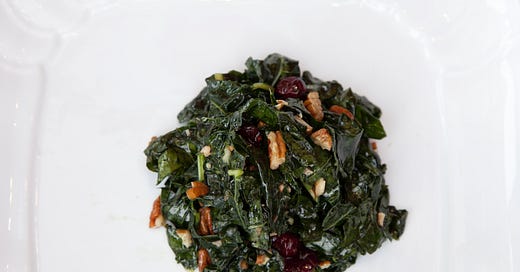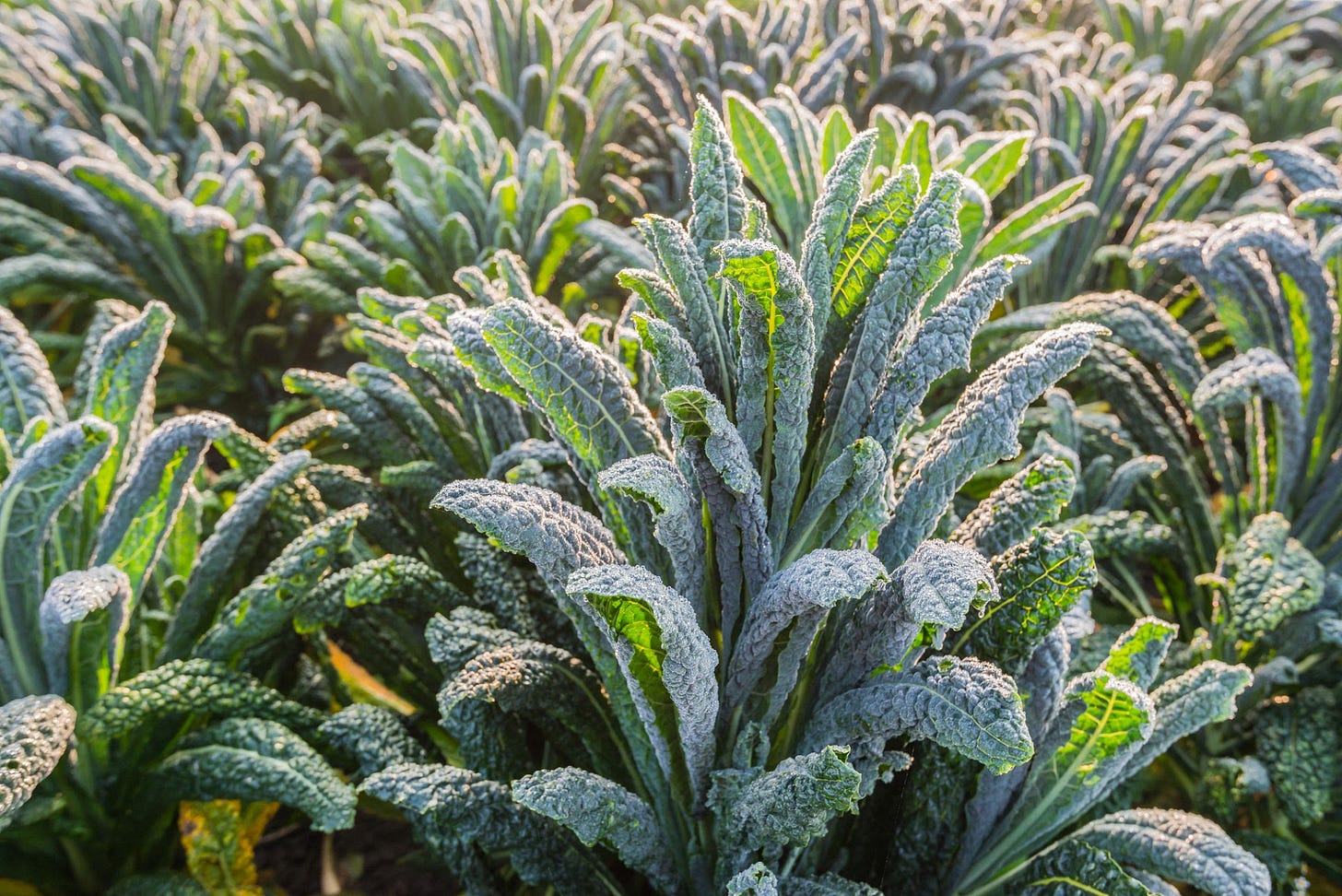Issue #110: All Hail, Kale Salad
My Version of the Culinary Cliché, Plus Some Insights into Italian Food Culture
Hi from New England, where “biblical” rains have led to historic flooding. We were personally unaffected, but it’s been the talk of the trip. Thinking back just a few weeks to forest fire smoke, record global heat, and simmering oceans, it seems clear that these sorts of “unusual events” are becoming the norm; climate change is here. We are all going to have to adapt. But that doesn’t mean we don’t still have a responsibility to minimize our own impact, reducing our carbon footprint, reusing and recycling things we buy, diminishing our consumption of plastic and everything, and supporting local, regenerative agriculture, as a start. Our lives and livelihoods literally depend on it. —Mitchell
I make this kale salad so often that I almost can’t believe I haven’t written about it before. (I’ve searched the Kitchen Sense archive many times and don’t see any mention of it. Forgive me if I am repeating myself.) Having witnessed kale in general and kale salad in particular move from obscurity to culinary clichés, I’m almost embarrassed to write about this salad now. I cannot tell you how many times I’ve sat in meetings where someone wanted to know which vegetable would become the next “kale.”
In fact, back in 2013, when a marketing executive friend of mine, Sara Brito, was engaged by none other than the New York Times to create a fictitious marketing campaign for one of the most maligned and underappreciated vegetables, broccoli (looking at you, George H. W.), the experts they gathered settled on kale as their nemesis. “Let’s pick a fight with kale,” one of the members of the satirical Broccoli Commission of America was quoted as saying. “Broccoli: Now 43 Percent Less Pretentious as Kale,” was one slogan the fake commission jokingly proposed.
But mine isn’t just any sourdough-lover, fermentation fanatic, bearded hipster’s kale salad. This is a sophisticated salad that owes a debt to celebrated chef Jonathan Waxman of Barbuto, who’s famous for his roast chicken, but who has always had a way with brassicas.
Although I’ve never read this in any analysis of kale’s meteoric rise in popularity, I’ve always believed that one of the reasons more people took interest in the fibrous leafy green vegetable was the arrival of lacinato kale in the marketplace. Known in Tuscany as cavolo nero or “black cabbage,” where it is a key ingredient in the iconic ribolita (bread and kale soup), lacinato, Tuscan, or dinosaur kale, as it is also known here, is a milder, more tender, easier to handle, and easier to digest form of kale than its tougher, curlier, decorative cousins. It was virtually unknown in the U.S. until it began appearing in the oft-neglected organic produce section of the grocery store, where its deep green, crocodile-embossed leaves stood strong and proud among the other wilted organic greens.
Given its prevalence in Italy and its popularity in America, I was all excited to include a cavolo nero salad among the offerings at the food truck park we built as part of the USA Pavilion at Expo Milano 2015, the first world’s fair devoted to the subject of food. I was Chief Creative Officer of the USA Pavilion and curator of the food. We included a lacinato kale salad on the menu as a snapshot of what was trendy in the US at the moment. But that salad was met by two unexpected cultural obstacles.
First, the Italian operators of our foodservice at the pavilion were puzzled by the suggestion of eating uncooked kale. Though cavolo nero is common in Tuscan soups and other cooked preparations, we were told Italians would be put off by the idea of eating it raw, something they’d never do. I was aware that many Italian preparations called for long cooking of vegetables, which I rather enjoy, but I never considered this tradition would result in a distaste for those same vegetables served raw (which also might explain the lack of variety in most Italian salads).
The second obstacle had two parts. Cavolo nero in Italy is both seasonal and regional, two words and concepts we like to throw around in American food circles, but which have very little import compared to Italy. Known mostly in Tuscany, our providers could not come by cavolo nero easily in Lombardy, the region where Milan sits. And even if they could find it, they wouldn’t be able to maintain a supply during summer (the Expo ran from May 1 to October 31) because it is primarily a winter vegetable. (Like collard greens and other brassicas, kale is known to become sweeter if picked after the first frost.) Despite being a winter dish, restaurants in Florence have been forced to serve kale-flecked ribolita all year long because summer tourists demand it. Consequently, any cavolo nero on the Italian market off season goes to that market and we couldn’t get what we needed in Milan in July.
When the kale ran out in Milan toward the end of May, we ended up substituting another cruciferous vegetable, broccoli raab, and to everyone’s surprise, especially the Italians’, it was delicious served raw and chopped fine in a salad. But my dreams of repatriating lacinato kale in salad form to our hundreds of thousands of food truck guests were dashed. (As you might have read in Issue #37, they really only wanted a hamburger, anyway.)
Last week, when we were in Maine for July 4th, we walked over to a new afternoon farmers market in Rockport to see what they had on offer. After a cold, rainy June, there wasn’t much produce yet, but one of the five stalls had some beautiful cavolo nero for sale. I bought two large bunches and made this salad for a picnic on a sailboat. It was devoured, as it always is, even by non-kale salad lovers.
This kale salad is simple to make. The hardest and most time consuming part is preparing the kale. But what I think makes it more palatable than other kale salads is that I remove the tough, central stem of the leaves and slice what remains very thinly into fine shreds. When dressed with acid and salt, the kale wilts, almost cooks, becoming tender and flavorful. No massaging required.
I have made a similar salad with different cruciferous vegetables, such as very thinly sliced brussels sprouts our cauliflower. I have substituted hazelnuts or almonds for the walnuts and Pecorino Romano or ricotta salata for the Parmigiano. But the original is still our favorite. While you may think you have too much kale, the shredding and wilting make that first impression deceptive. Nate and/or I can and have eaten this entire recipe. But you could also divide it among six to eight people as a side dish with other things. After a night in the fridge, when it has wilted even more, the leftovers make an excellent addition to a sandwich.
RECIPE: Tuscan Kale Salad
(Serves 2 to 8)
½ cup walnut halves
2 large bunches lacinato kale, also known as Tuscan or dinosaur kale, cavolo nero or black cabbage
2 lemons
1 to 2 ounces Parmigiano-Reggiano, finely grated
1/3 cup extra-virgin olive oil
Salt and freshly ground black pepper, to taste
Place the walnuts on a tray and toast in a 300°F. oven for 8 to 10 minutes, until you can smell them toasting and they have darkened just slightly. Set a timer or you are likely to burn them. Cool.
While the nuts are toasting and cooling, clean the kale. I like to lay each leaf flat on a cutting board and trace a “v” with the tip of a knife along both sides of the central stem to remove it. Place the leafy part in a salad spinner. Repeat with the remaining kale until all of the leaves are destemmed. You can keep the smaller leaves intact. Fill the salad spinner with water to rinse the leaves. Lift them out of the water and spin dry. Now, bunch the cleaned leaves on the cutting board under one hand, as you would to chop herbs, and use a sharp chef’s knife to thinly slice the kale into fine shreds. Place the cut kale into a large mixing bowl. Repeat until all of the leaves are shredded. This is the longest process of making this salad, but it’s worth the effort for the final result.
Using the same sharp knife, finely slice and chop the toasted walnuts and add them to the bowl with the kale. Zest two lemons into the same bowl. Juice only one of the lemons, removing any seeds, and add that as well. Add the grated parmesan, olive oil, and a generous pinch of salt and freshly ground black pepper. Using tongs, toss the salad well. Mixing it takes some focus because the kale, cheese, and other ingredients tend to clump. Don’t give up until it is fully mixed. Using a mixing bowl that seems like it might be too large helps prevent making a mess of your kitchen. Taste and adjust the seasoning.
Let the salad sit for at least 30 minutes or up to a couple of hours before serving so the kale has time to absorb the dressing and wilt.
VARIATIONS
Substitute thinly sliced and shredded brussels sprouts, cauliflower, cabbage, kohlrabi, or broccoli raab for the kale.
Use hazelnuts, almonds, pine nuts, or any nut you prefer instead of walnuts.
Add walnut or any other nut oil to the olive oil for the dressing.
Use Pecorino Romano or Ricotta Salata instead of the parmigiano for the cheese.
Add dried currants, cranberries, blueberries, or other dried fruit to the mix.








Sounds yummy and easy (I think).
Love it! Always!